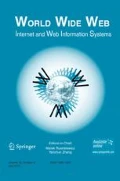Abstract
Social media enables people to communicate with each other on the Internet in real-time and rich styles. In other words, there is a lot of information on the social media. If we can extract negative opinions of some brands, enterprises or politics, we can use these opinions to know the market demands and solve problems. In this paper, we propose a novel approach to extract negative-sentiment-oriented features and identify negative opinions in social media with text mining and machine learning techniques, support vector machine and neural network, as well as data collection with Web crawler. The experimental results show that our proposed methods can work effectively.










Similar content being viewed by others
References
Alexa Internet.: https://www.alexa.com/siteinfo/mobile01.com (2016). Accessed Jan 2016
Beautiful Soup.: https://www.crummy.com/software/BeautifulSoup/ (2016). Accessed Mar 2016
Ben-Hur, A., Weston, J.: A User’s Guide to Support Vector Machines. In: A User’s Guide to Support Vector Machines. Humana Press, New York (2010)
Bylinskii, Z.: “SVM tutorial”. http://pantherfile.uwm.edu/borji/www/lecturesML/SVM/SVM.pdf, (2012). Accessed Feb 2017
Chang, C.-C., Lin, C.-J.: LIBSVM: a library for support vector machines. ACM Trans. Intell. Syst. Technol. 2(3), 1–27 (2011)
Chang, J.K., Hsu, W.Y., Chen, T.C., Hsu, H.H.: Identification of negative comments on internet forums. 10th International Conference on Innovative Mobile and Internet Services in Ubiquitous Computing (IMIS). 435–439 (2016)
Chawla, N.V., Bowyer, K.W., Hall, L.O., Kegelmeyer, W.P.: SMOTE: synthetic minority over-sampling technique. J. Artif. Int. Res. 16(1), 321–357 (2002)
CKIP word segmentation system.: http://ckipsvr.iis.sinica.edu.tw/ (2015). Accessed Apr 2016
Farhadloo, M., Rolland, E.: Multi-class sentiment analysis with clustering and score representation. In: IEEE 13th International Conference on Data Mining Workshops, pp. 904–912 (2013)
Gupta, P., Johari, K.: Implementation of web crawler. Second International Conference on Emerging Trends in Engineering & Technology. 838–843 (2009)
Gurney, K.: An Introduction to Neural Networks. CRC press, Boca Raton (1997)
HIT-CIR Tongyici Cilin (Extended ver.).: http://ir.hit.edu.cn/demo/ltp/Sharing_Plan.htm. Accessed Apr 2016
Jieba Chinese text segmentation.: https://github.com/fxsjy/jieba/ (2013) Accessed Jan 2016
Keras Documentation, https://keras.io/. Accessed Aug 2017
Klambauer, G.n., Unterthiner, T., Mayr, A., Hochreiter, S.: Self-normalizing neural networks. In: Advances in Neural Information Processing Systems 2017, pp. 971--980
Ku, L.-W., Chen, H.-H.: Mining opinions from the web: beyond relevance retrieval. J. Am. Soc. Inf. Sci. Technol. 58(12), 1838–1850 (2007)
Measuring the Information Society Report.: https://www.itu.int/en/ITU-D/Statistics/Documents/publications/misr2016/MISR2016-w4.pdf (2017). Accessed Feb 2017
P, H.R., Ahmad, T.: Fuzzy based sentiment analysis of online product reviews using machine learning techniques. International Journal of Computer Applications 99, 9–16 (2014)
Pedregosa, F., Varoquaux, G., Gramfort, A., et al.: Scikit-learn: machine learning in Python. J. Mach. Learn. Res. 12, 2825–2830 (2011)
Sun, Y.T., Chen, C.L., Liu, C.C., Liu, C.L., Soo, V.W.: Sentiment classification of short Chinese sentences. In: Proceedings of the 22nd Conference on Computational Linguistics and Speech Processing, Nantou, Taiwan, pp. 184–198 (2010)
Vapnik, V.N.: An overview of statistical learning theory. IEEE Trans. Neural Netw. 10(5), 988–999 (1999)
Yang, C., Lin, K.H.Y., Chen, H.H.: Emotion classification using web blog corpora. IEEE/WIC/ACM International Conference on Web Intelligence. 275–278 (2007)
Acknowledgements
This research was partially supported by Ministry of Science and Technology, Taiwan, under grant no. MOST 106-3114-E-009-008 and MOST 104-2811-E-009-050.
Author information
Authors and Affiliations
Corresponding author
Additional information
Guest Editors: Timothy K. Shih, Lin Hui, Somchoke Ruengittinun, and Qing Li
This article belongs to the Topical Collection: Special Issue on Social Media and Interactive Technologies
Rights and permissions
About this article
Cite this article
Hsu, WY., Hsu, HH. & Tseng, V.S. Discovering negative comments by sentiment analysis on web forum. World Wide Web 22, 1297–1311 (2019). https://doi.org/10.1007/s11280-018-0561-6
Received:
Revised:
Accepted:
Published:
Issue Date:
DOI: https://doi.org/10.1007/s11280-018-0561-6




